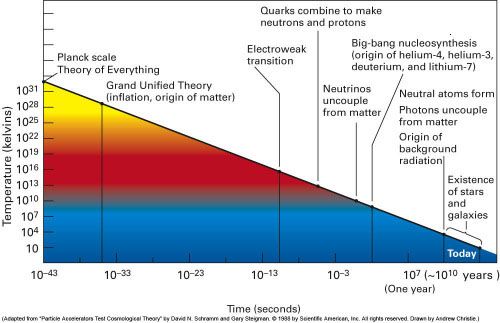Cosmos: The Big Bang

The universe emerged instantaneously some 13.7 billion years ago in a unique kind of explosion known as the Big Bang. Two features of that creation are mysteries for science. The first is that speed of the explosion, which was an acceleration from nothing and greater than the laws of physics allow. What occurred in the first mini-fraction of the first second is still not completely understood, but the favored explanation is called the "inflation." That tiny but spectacular amount of time is not to be confused with the later expansion of the universe -the expansion that followed the Big Bang.
The second feature of the Big Bang that physicists try to understand is the uniformity of the "bang". In typical explosions, material is not uniformly dispersed, but in the Big Bang the material of the nascent universe was apparently dispersed very evenly. Of course, everything about the Big Bang was incomparable and it is very difficult to reconstruct that moment. Many features of the creation, including the unimaginable heat and density of that tiny universe, have no equal in the cosmos now. Matter as we know it did not yet exist and the forces of nature had not really formed. But as the universe rapidly expanded and cooled the fundamental forces --gravity, electromagnetism, the weak force, the strong force-- separated. The first particles and anti-particles emerged, including the familiar photon, neutrino, electron and positron. Protons and neutrons quickly formed the first atomic nuclei --but not yet atoms-- in a process known as Big Bang nucleosynthesis. These nuclei were isotopes of hydrogen and helium, plus trace amounts of lithium. Electrons, the other component of the atom, remained free until much later. Actual atoms did not form until almost 400,000 years later.
The most significant evidence for the Big Bang origin comes from two sources: the present ratio of helium to hydrogen in the universe; and the distribution of the radiation from the Big Bang, known as the Cosmic Microwave Background Radiation, or CMB. In the 1960s scientists discovered that the leftover radiation from the Big Bang was evenly distributed across the universe. The background radiation as evidence for the Big Bang origin of the universe. The shading variations in the graphic represent the very subtle temperature differences in the radiation background.
Recombination. After about 380,000 years, the universe had cooled enough (about 3000 K) for the hydrogen and helium nuclei to bind with free electrons to form the first and simplest atoms. This era is known as Recombination. The chemical composition of the universe has remained quite stable since that time, consisting of approximately 70 percent hydrogen and 28 percent helium. That ratio of helium to hydrogen is nearly identical to that period of the early universe. Virtually all of the heavier elements that comprise baryonic matter were created in the stars that came much later.
During the period of recombination, the cooler state of the universe made it possible for photons to separate --or decouple-- from electrons in the nuclear soup. Once the photons could move freely, the universe changed from an dark opaque state to a dark transparent one. The radiation from that event appears to be evenly distributed over the known universe, and is called the Cosmic Microwave Background Radiation, or CMB. The CMB is important evidence for the Big Bang theory, because it confirms that the cosmos began as a sudden, huge burst and that the burst spewed the radiation almost evenly.

Reionization. After recombination, photons could move freely and the universe became transparent, but there were no stars, hence no visible light. The universe remained in a protracted Dark Ages state for the first 200 million years or more. Then, very gradually, scattered clumps of denser gas began to take shape in the previously smooth distribution of matter. In these dense clouds of hydrogen the first stars began to form. The radiation from the early stellar objects, together with the continued expansion of the universe, caused the reionization, first of hydrogen atoms, and later, of helium atoms, resulting in the version of those atoms familiar to us today.
